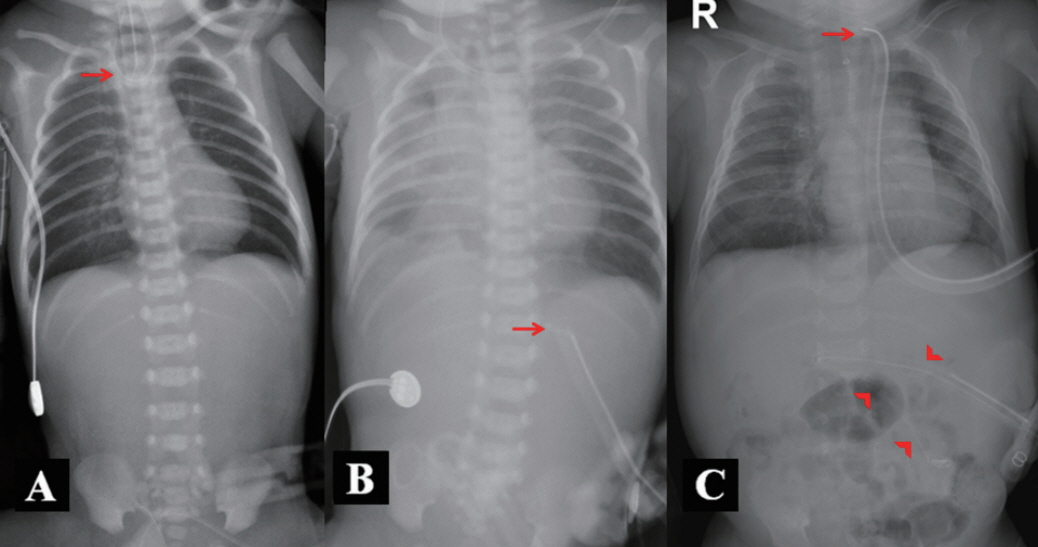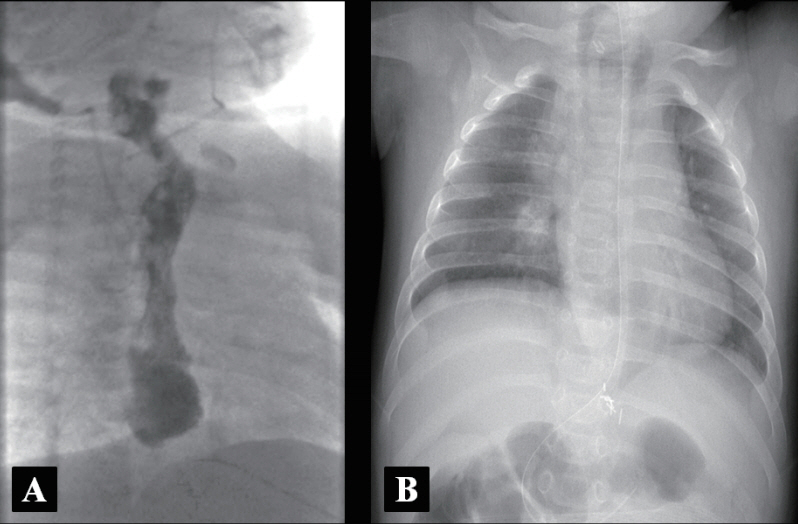Neonatal Med.
2018 Nov;25(4):186-190. 10.5385/nm.2018.25.4.186.
Esophageal Reconstruction with Gastric Pull-up in a Premature Infant with Type B Esophageal Atresia
- Affiliations
-
- 1Division of Neonatology, Department of Pediatrics, Pusan National University Children's Hospital, Pusan National University School of Medicine, Yangsan, Korea.
- 2Division of Pediatric Surgery, Department of Surgery, Pusan National University Yangsan Hospital, Pusan National University School of Medicine, Yangsan, Korea. choyh70@pusan.ac.kr
- KMID: 2436137
- DOI: http://doi.org/10.5385/nm.2018.25.4.186
Abstract
- Esophageal atresia (EA) with proximal tracheoesophageal fistula (TEF; gross type B) is a rare defect. Although most patients have long-gap EA, there are still no established surgical guidelines. A premature male infant with symmetric intrauterine growth retardation (birth weight, 1,616 g) was born at 35 weeks and 5 days of gestation. The initial diagnosis was pure EA (gross type A) based on failure to pass an orogastric tube and the absence of stomach gas. A "feed and grow" approach was implemented, with gastrostomy performed on postnatal day 2. A fistula was detected during bronchoscopy for recurrent pneumonia; thus, we confirmed type B EA and performed TEF excision and cervical end esophagostomy. As the infant's stomach volume was insufficient for bolus feeding after reaching a body weight of 2.5 kg, continuous tube feeding was provided through a gastrojejunal tube. On the basis of these findings, esophageal reconstruction with gastric pull-up was performed on postnatal day 141 (infant weight, 4.7 kg), and he was discharged 21 days postoperatively. At 12 months after birth, there was no catch-up growth; however, he is currently receiving a baby food diet without any complications. In patients with EA, bronchoscopy is useful for confirming TEF, whereas for those with long-gap EA with a small stomach volume, esophageal reconstruction with gastric pull-up after continuous feeding through a gastrojejunal tube is worth considering.
MeSH Terms
Figure
Reference
-
1. Spitz L. Oesophageal atresia. Orphanet J Rare Dis. 2007; 2:24.2. Spitz L, Kiely EM, Morecroft JA, Drake DP. Oesophageal atresia: at-risk groups for the 1990s. J Pediatr Surg. 1994; 29:723–5.3. Yagyu M, Gitter H, Richter B, Booss D. Esophageal atresia in Bremen, Germany: evaluation of preoperative risk classification in esophageal atresia. J Pediatr Surg. 2000; 35:584–7.4. Sinha CK, Haider N, Marri RR, Rajimwale A, Fisher R, Nour S. Modified prognostic criteria for oesophageal atresia and tracheo-oesophageal fistula. Eur J Pediatr Surg. 2007; 17:153–7.5. Chang EY, Chang HK, Han SJ, Choi SH, Hwang EH, Oh JT. Clinical characteristics and treatment of esophageal atresia: a single institutional experience. J Korean Surg Soc. 2012; 83:43–9.6. Cho SH, Oh BS, Lee DJ. End to end anastomosis of type A (long gap) esophageal atresia in 1200 gram premature baby: a case report. Korean J Thorac Cardiovasc Surg. 1997; 30:236–40.7. Lee DS, Namgung H, Yoon JS. Long gap esophageal atresia successfully treated by esophageal lengthening using external traction sutures. J Korean Assoc Pediatr Surg. 2005; 11:165–70.8. Kim HT, Bae WJ, Jung SL, Lee JW. A case of the esophageal atresia with proximal tracheoesophageal fistula. J Korean Pediatr Soc. 1998; 41:861–4.9. Torfs CP, Curry CJ, Bateson TF. Population-based study of tracheoesophageal fistula and esophageal atresia. Teratology. 1995; 52:220–32.10. Esophageal atresia and tracheoesophageal fistula. In : Martin RJ, Faranoff AA, Walsh MC, editors. Fanaroff and Martin's neonatal-perinatal medicine: diseases of the fetus and infant. 10th ed. Philadelphia: Elsevier Saunders;2015. p. 1395–400.11. Koivusalo AI, Sistonen SJ, Lindahl HG, Rintala RJ, Pakarinen MP. Long-term outcomes of oesophageal atresia without or with proximal tracheooesophageal fistula: gross types A and B. J Pediatr Surg. 2017; 52:1571–5.12. Zani A, Eaton S, Hoellwarth ME, Puri P, Tovar J, Fasching G, et al. International survey on the management of esophageal atresia. Eur J Pediatr Surg. 2014; 24:3–8.13. Atzori P, Iacobelli BD, Bottero S, Spirydakis J, Laviani R, Trucchi A, et al. Preoperative tracheobronchoscopy in newborns with esophageal atresia: does it matter? J Pediatr Surg. 2006; 41:1054–7.14. Waterston DJ, Carter RE, Aberdeen E. Oesophageal atresia: tracheo-oesophageal fistula. A study of survival in 218 infants. Lancet. 1962; 1:819–22.15. Poenaru D, Laberge JM, Neilson IR, Guttman FM. A new prognostic classification for esophageal atresia. Surgery. 1993; 113:426–32.16. Botero D, Lifshitz F. Intrauterine growth retardation and longterm effects on growth. Curr Opin Pediatr. 1999; 11:340–7.17. Neu J. The human gut microbiota in perinatology and neonatology. Semin Fetal Neonatal Med. 2016; 21:367.18. Boyle EM Jr, Irwin ED, Foker JE. Primary repair of ultra-long-gap esophageal atresia: results without a lengthening procedure. Ann Thorac Surg. 1994; 57:576–9.19. Foker JE, Linden BC, Boyle EM Jr, Marquardt C. Development of a true primary repair for the full spectrum of esophageal atresia. Ann Surg. 1997; 226:533–41.20. Jung SL. A case of the esophageal atresia with distal tracheoesophageal fistula associated with duodenal obstrction. J Korean Soc Neonatol. 1998; 5:217–20.
- Full Text Links
- Actions
-
Cited
- CITED
-
- Close
- Share
- Similar articles
-
- Transhiatal gastric transposition of a long gap esophageal atresia
- Esophageal Atresia without Tracheoesophageal Fistula: Report of 6 Cases
- End to End Anastomosis of Type A(long gap) Esophageal Atresia in 1200 gram Premature Baby: a case report
- Reversed Gastric Tube Interposition in Esophageal Atresia
- Gastric Tube Replacement in Esophageal Atresia



